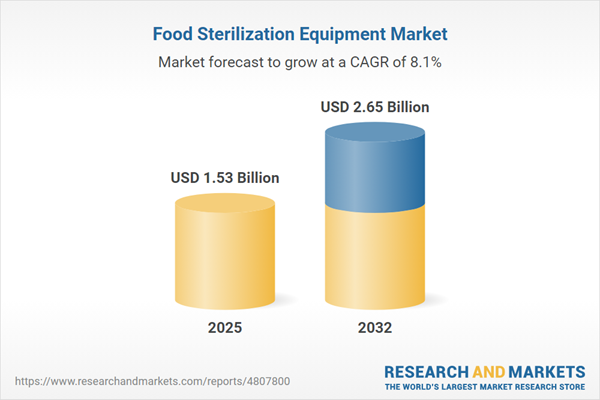Speak directly to the analyst to clarify any post sales queries you may have.
The food sterilization equipment market is undergoing notable transformation, propelled by regulatory pressures, technology innovation, and shifting consumer preferences for safe, minimally processed foods. As demand grows and industry standards evolve, manufacturers and processors are prioritizing advanced solutions to ensure operational resilience and product integrity across global food supply chains.
Market Snapshot: Food Sterilization Equipment Market Size and Growth
The food sterilization equipment market grew from USD 1.42 billion in 2024 to USD 1.53 billion in 2025. It is projected to expand at a CAGR of 8.11%, reaching USD 2.65 billion by 2032. This sustained growth is attributed to stringent food safety regulations, the adoption of innovative sterilization technologies, and investment in both established and emerging economies.
Scope & Segmentation
This report offers comprehensive coverage of the food sterilization equipment market across multiple dimensions, including technology, application, and region.
- Sterilization Methods: Chemical (ethylene oxide, hydrogen peroxide), dry heat (batch oven, tunnel sterilizer), filtration (microfiltration, ultrafiltration), moist heat (autoclave, retort), and radiation (E-Beam, gamma).
- Product Types: Liquid, semi-solid (paste, pulp), and solid (granules, powder) formulations.
- Process Types: Batch sterilization and continuous sterilization systems.
- Automation Levels: Automatic, manual, and semi-automatic equipment to support a range of operational needs.
- End Users: Beverage manufacturing (including alcoholic, juices, soft drinks), dairy (cheese, milk, yogurt), food processing (fruit and vegetable, seafood, snacks), and meat and poultry processing (fresh, frozen, red meat, poultry).
- Geographical Regions: Americas (United States, Canada, Mexico, Brazil, Argentina, Chile, Colombia, Peru), Europe, Middle East & Africa (United Kingdom, Germany, France, Russia, Italy, Spain, Netherlands, Sweden, Poland, Switzerland, United Arab Emirates, Saudi Arabia, Qatar, Turkey, Israel, South Africa, Nigeria, Egypt, Kenya), and Asia-Pacific (China, India, Japan, Australia, South Korea, Indonesia, Thailand, Malaysia, Singapore, Taiwan).
- Selected Companies: Alfa Laval AB, SPX Flow Inc., Hiperbaric S.A., Kissel+Wolf GmbH, Bucher Unipektin AG, CFT S.p.A., Allpax Products, CFT Group, Sumpot, BMT USA, Consolidated Sterilizer Systems, Cosmed Group, TERRA Food-Tech, CN Food Machines, STERIS Corporation, and Middleby Corporation.
Key Takeaways for Decision-Makers
- Regulatory compliance is shaping equipment adoption, driving demand for solutions that meet evolving global standards and regional requirements.
- Non-thermal and hybrid sterilization methods are gaining traction, especially where sensory and nutritional quality preservation is critical.
- Automation and digital integration, including IoT-enabled sensors and predictive analytics, are advancing process efficiencies and reducing operational risks.
- Sustainability is a core consideration, with companies exploring eco-friendly sterilants and energy recovery modules to lessen environmental impacts.
- Modular equipment designs and adaptive supply chains support flexibility in sourcing and manufacturing, equipping firms to address trade or geopolitical uncertainties.
- Collaborative partnerships between manufacturers and technology providers are enabling co-innovation and tailored solutions that reflect end-user needs across regions.
Tariff Impact on US Food Sterilization Equipment Market
Recent US tariff adjustments have introduced complexity for equipment manufacturers reliant on imported components. Companies are mitigating cost pressures by localizing assembly, establishing regional supplier partnerships, and innovating modular platforms for greater sourcing flexibility. These strategies help offset input cost volatility while improving supply chain responsiveness and compliance with domestic standards.
Methodology & Data Sources
This research is based on a mixed-method approach, combining structured interviews with industry executives, expert roundtables, and secondary analysis of trade journals, regulatory documents, and company disclosures. Comprehensive data triangulation ensures robust insights into market trends and technology advances.
Why This Report Matters
- Equip leadership teams with actionable intelligence to support strategic decisions in capital allocation, technology adoption, and market expansion.
- Facilitate in-depth benchmarking of product portfolios and supply chain strategies against evolving competitor and regulatory dynamics.
Conclusion
The food sterilization equipment market is set for sustained advancement driven by innovation, regulatory developments, and evolving consumer needs. Senior decision-makers equipped with timely insights can better align their strategies for long-term resilience and growth in this dynamic sector.
Additional Product Information:
- Purchase of this report includes 1 year online access with quarterly updates.
- This report can be updated on request. Please contact our Customer Experience team using the Ask a Question widget on our website.
Table of Contents
3. Executive Summary
4. Market Overview
7. Cumulative Impact of Artificial Intelligence 2025
Companies Mentioned
The companies profiled in this Food Sterilization Equipment market report include:- Alfa Laval AB
- SPX Flow, Inc.
- Hiperbaric S.A.
- Kissel+Wolf GmbH
- Bucher Unipektin AG
- CFT S.p.A.
- Allpax Products
- CFT Group
- Sumpot
- BMT USA
- Consolidated Sterilizer Systems
- Cosmed Group
- TERRA Food-Tech
- CN Food Machines
- STERIS Corporation
- Middleby Corporation
Table Information
| Report Attribute | Details |
|---|---|
| No. of Pages | 185 |
| Published | November 2025 |
| Forecast Period | 2025 - 2032 |
| Estimated Market Value ( USD | $ 1.53 Billion |
| Forecasted Market Value ( USD | $ 2.65 Billion |
| Compound Annual Growth Rate | 8.1% |
| Regions Covered | Global |
| No. of Companies Mentioned | 17 |









